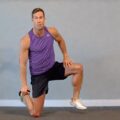Understanding Front Squats and Back Squats
Squats are a fundamental exercise that can significantly enhance your overall strength and fitness. Two popular variations of this powerful movement are front squats and back squats. While both exercises target similar muscle groups, they each offer unique benefits and challenges. In this article, we’ll explore the differences between front squats and back squats, helping you understand which might be better suited for your fitness journey and personal goals.
The Mechanics of Front Squats
Front squats are performed with the barbell resting on the front of your shoulders, typically supported by your fingertips in a “rack” position. This variation requires:
- A more upright torso position
- Greater core engagement
- Increased mobility in the wrists, elbows, and shoulders
The unique positioning of the bar in front squats places a greater emphasis on the quadriceps and core muscles. Many people find that front squats feel more comfortable on their lower back, making them an excellent option for those with back concerns.
The Mechanics of Back Squats
Back squats involve placing the barbell across your upper back, typically resting on your trapezius muscles. This classic squat variation:
- Allows for heavier loads to be lifted
- Engages more of the posterior chain (back, glutes, and hamstrings)
- Requires less mobility in the upper body
Back squats are often considered the “king of exercises” due to their ability to build overall strength and muscle mass effectively. They’re a staple in many strength training programs and are particularly popular among powerlifters and bodybuilders.
Choosing Between Front Squats and Back Squats
When deciding between front squats and back squats, it’s essential to consider your goals, physical condition, and personal preferences. Here are some factors to keep in mind:
- Goal-oriented choice: If your primary goal is to build overall strength and muscle mass, back squats might be the better choice. If you’re focused on developing your core strength and quadriceps, front squats could be more beneficial.
- Injury considerations: Those with lower back issues often find front squats more comfortable due to the more upright torso position. However, individuals with wrist or shoulder mobility limitations might prefer back squats.
- Sport-specific training: Athletes in sports that require a more upright posture (like Olympic weightlifting) may benefit more from front squats, while powerlifters typically favor back squats.
- Variety in training: Incorporating both types of squats into your routine can provide a well-rounded approach to lower body strength training.
Remember, the “best” squat variation is the one that aligns with your goals, feels comfortable, and allows you to maintain proper form consistently.
The Importance of Proper Form
Regardless of which squat variation you choose, maintaining proper form is crucial for both safety and effectiveness. Here are some key points to remember:
- Keep your core engaged throughout the movement
- Maintain a neutral spine
- Push through your heels as you stand up
- Keep your knees in line with your toes
- Breathe consistently – inhale as you lower, exhale as you rise
If you’re new to squatting or unsure about your form, consider working with a qualified fitness professional who can provide personalized guidance and ensure you’re performing the exercise safely and effectively.
Embracing the Journey of Strength and Wellness
Whether you choose front squats, back squats, or a combination of both, remember that your fitness journey is unique to you. It’s not about comparing yourself to others or pushing yourself to extremes. Instead, focus on gradual progress, listening to your body, and celebrating the small victories along the way.
Squats, in any form, can be a powerful tool for building strength, improving mobility, and boosting confidence. They remind us of our body’s incredible capabilities and the importance of staying connected to our physical selves in our often sedentary modern lives.
As you incorporate squats into your routine, approach them with patience and self-compassion. Some days will feel easier than others, and that’s perfectly normal. What matters most is your commitment to showing up for yourself and nurturing your body through movement.
Frequently Asked Questions
1. Are front squats safer than back squats?
Neither variation is inherently safer than the other. The safety of any exercise depends on proper form and appropriate loading. Front squats may be preferable for those with lower back issues due to the more upright torso position, but both can be performed safely with proper technique and progression.
2. Can I do both front squats and back squats in my workout routine?
Absolutely! Incorporating both variations can provide a well-rounded approach to lower body strength training. You might choose to alternate between front and back squats on different workout days or within the same session, depending on your goals and program design.
3. Do I need special equipment for front squats?
While a barbell is typically used for front squats, you can also perform them with dumbbells or kettlebells. The key is to maintain the weight in front of your body at shoulder level. No special equipment is necessary beyond what you’d use for regular squats.
4. How deep should I squat?
The ideal squat depth can vary based on individual factors like mobility and goals. Generally, aiming for at least parallel (where your thighs are parallel to the ground) is a good target. Some people may comfortably squat deeper, while others may need to work on mobility to achieve full depth. Listen to your body and focus on maintaining good form throughout the movement.
5. How often should I include squats in my workout routine?
The frequency of squatting depends on your overall training program and recovery capacity. For beginners, 2-3 times per week is often sufficient. More advanced lifters might squat more frequently. Always allow adequate rest between sessions and pay attention to how your body responds. Remember, consistency over time is more important than frequency within a single week.









